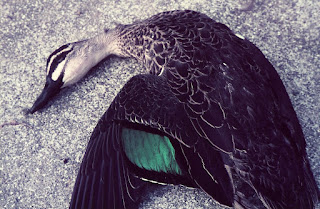Here’s a
bit of a catchup on my whale investigations. I’ve started looking at whales and
whaling in Southland for a booklet coming out in about twelve months. The most recent stranding in Southland
is a humpback, at least the fourth in ten years. These big guys don’t get stranded alive;
they die at sea and drift ashore.
If the bodies get stuck in the inter-tidal zone they break down quite
rapidly. One which washed up on 1
November at Mason Bay on Stewart Island had largely disintegrated by 9 December
with each tide bringing a new wave of crustaceans to nibble the flesh and wash
away the loosed debris to expose more meat for the tearing gulls. If it had been cast up above high tide by
an exceptional tide, then it’s the flies that break it down and that process
takes years.
Humpbacks were hammered by the shore whalers and it was this species that kept the last of the whalers – the Tory Channel ones – going until the early 1960s. There had been an extensive humpback fishery on the Northland east coast until then. The whales were trapped by huge nets across the mouths of bays, harpooned and dragged ashore for flensing.
Some of the
vertebrae and other bones had separated from this carcass. The back of the skull was detached and
showed a severe growth of cancerous bone which may have contributed to the
whale’s death. Sea mammals suffer
the human diseases of old age as they are amongst the few animals to actually
reach advanced years. For other
species, advancing weakness or illness makes them vulnerable to predation and
they are quickly killed and eaten.
Whale bones often show arthritis and osteoporosis.
The whale’s
radius and ulna were protruding from the carcass. These are the longest radius and ulna of
any sea creature that ever lived - longer than the equivalent bones on the Blue
whale and exceeding those of any of the giant marine reptiles.
Further
south along Mason Bay the last remains of the Pilot whales that stranded in
February 2011 are slipping from view.
Here and there you see a rib or vertebra on the beach and there are still
a dozen skulls, much battered after this time.
It was on
this spot that Pilot whales, or Blackfish, as they were known, were herded
ashore by Stewart Island fishermen.
The iron pots were brought around from Oban and the carcasses were boiled
for their oil.
From
time to time the suggestion comes up for using stranded whales and dolphins for
food – a cultural issue rather than one of necessity. There is plenty of historical precedent
for eating whales and dolphins and whale meat is available in Japan, Norway and
other countries. In wartime Britain
canned whale meat from the Antarctic whale fishery supplemented beef and mutton
although it was eaten unenthusiastically.
There is a big difference between the meat of baleen whales and toothed
whales with the Sperm whale in particular giving a dark, oily meat with noted
laxative powers, while the meat of the rorquals – Blue, Fin, Minke and Sei and
Bryde’s whales – is milder, paler and better flavoured.
Whale meat is low in cholesterol and calories and high
in Omega-3 oils but the prospect for the harvest of meat from stranded cetaceans
is bleak for several reasons.
1) The
insulating layer of blubber on a large whale effectively prevents the carcass
from cooling after death and the temperature rises rather than falls. Decomposition begins rapidly in the hot
lifeless tissues and the meat is inedible after a few hours. Commercially harvested whale meat is
removed from the body and chilled quickly aboard a factory
ship.
2) As the
cause of death is usually not obvious, the whale may have died from a disease
that may be transmissible to humans or may render the meat
toxic.
3) Being
top carnivores, marine mammals accumulate natural and man-made toxins which
remain in the food chain.
Pesticides, such as DDT, and heavy metals, especially mercury, can be at
a dangerously high levels, as can the natural level of vitamin A in seal
livers.
So
there goes the case for eating meat from stranded carcasses. They can provide other useful bits
though. Although whales dead and
alive are protected, it is lawful to remove bones and teeth that have separated
naturally from the carcass. Bone,
especially the jaw of the Sperm whale, is much prized by carvers, as are the
teeth. Baleen, formerly removed
from Right whales to make corset stays, umbrella ribs and the springy bottoms of
chairs, can be used for carving, and the large vertebrae are used for garden
seats. By the way, we don’t know
why it is called the Right whale.
It was clearly the wrong whale to hunt as its oil was inferior and it was
regarded with distain by the whalers, for whom the ‘right whale’ was the Sperm
whale.











